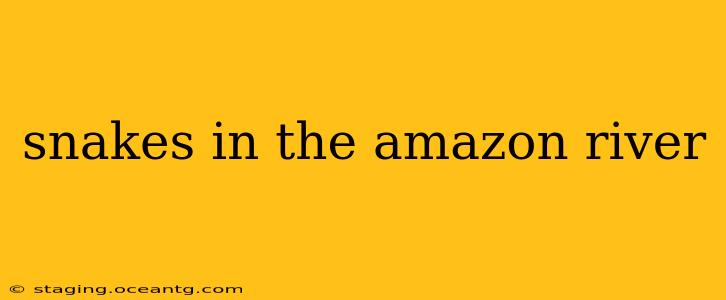The Amazon River, a colossal waterway teeming with life, is also home to a diverse array of snakes. From the massive anaconda to smaller, less-known species, these reptiles play a crucial role in the Amazon's complex ecosystem. This exploration delves into the fascinating world of Amazonian snakes, addressing common questions and highlighting the unique adaptations that allow them to thrive in this challenging environment.
What types of snakes live in the Amazon River?
The Amazon basin boasts an incredible diversity of snake species, many of which are semi-aquatic or fully aquatic. Some of the most well-known include:
-
Green Anacondas ( Eunectes murinus): These behemoths are among the world's largest snakes, capable of reaching lengths exceeding 20 feet. They are ambush predators, primarily feeding on birds, mammals, and even caimans. While not exclusively riverine, they are heavily associated with aquatic environments.
-
Yellow Anacondas (Eunectes notaeus): Smaller than their green cousins, yellow anacondas are also formidable predators, inhabiting similar habitats.
-
Water Boas (Epicrates cenchria): These relatively slender snakes are excellent swimmers and often found near water bodies, preying on smaller animals like rodents and birds. Their coloration varies considerably.
-
Various species of aquatic snakes: Numerous smaller, less-studied snake species inhabit the Amazon's rivers, streams, and flooded forests. Many are specialized for aquatic life, possessing adaptations like laterally compressed bodies and valvular nostrils to aid in swimming and underwater breathing.
Are there poisonous snakes in the Amazon River?
While many Amazonian snakes are non-venomous constrictors, several venomous species also call the river and its surrounding areas home. These include various species of:
-
Coral snakes: These brightly colored snakes possess potent neurotoxic venom. Their distinctive banding patterns are crucial for identification, helping to distinguish them from harmless mimics.
-
Viper species: Some pit vipers, known for their heat-sensing pits, are found near the river and are venomous.
It's crucial to remember that encountering venomous snakes in the Amazon requires extreme caution. Avoid handling any snake you encounter, and seek medical attention immediately if bitten.
What is the largest snake in the Amazon River?
The Green Anaconda is undoubtedly the largest snake found in the Amazon River basin. Their impressive size and power make them apex predators in their environment.
How dangerous are the snakes in the Amazon River?
The danger posed by Amazonian snakes varies greatly depending on the species. While some are harmless to humans, others possess potent venom or are capable of inflicting serious injury through constriction. Respecting their space and avoiding unnecessary contact is paramount to ensuring safety.
What do Amazon River snakes eat?
The diet of Amazonian snakes is diverse and largely determined by their size and species. Larger snakes like anacondas prey on larger animals, while smaller snakes focus on smaller prey. Common food sources include:
- Fish
- Birds
- Mammals (rodents, monkeys, etc.)
- Reptiles (lizards, caimans)
- Amphibians
How to avoid snakes in the Amazon River?
Avoiding snake encounters in the Amazon requires a cautious approach:
- Stick to marked trails: Staying on established paths reduces the chance of encountering snakes in their natural habitat.
- Wear appropriate footwear: Boots protect your feet from snakebites.
- Be mindful of your surroundings: Look where you step and place your hands.
- Avoid areas with dense vegetation: Snakes often seek shelter in dense vegetation.
- Use a flashlight at night: This helps to illuminate potential hazards.
The Amazon River's snake population is a fascinating and vital part of its ecosystem. Understanding their diversity, behavior, and potential dangers is essential for anyone venturing into this incredible region. Remember to prioritize safety and respect the wildlife.
